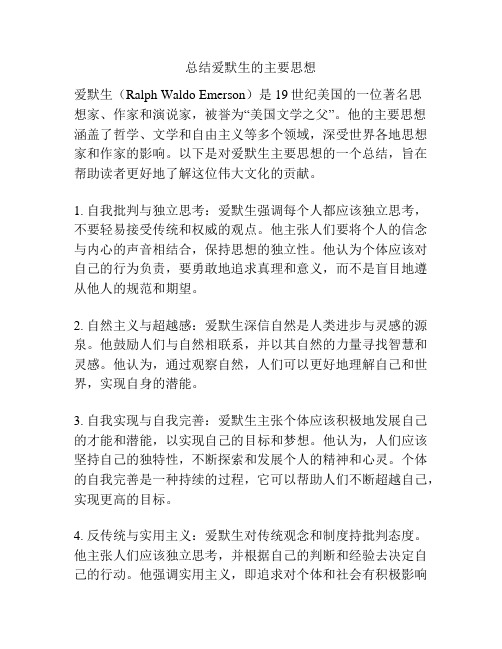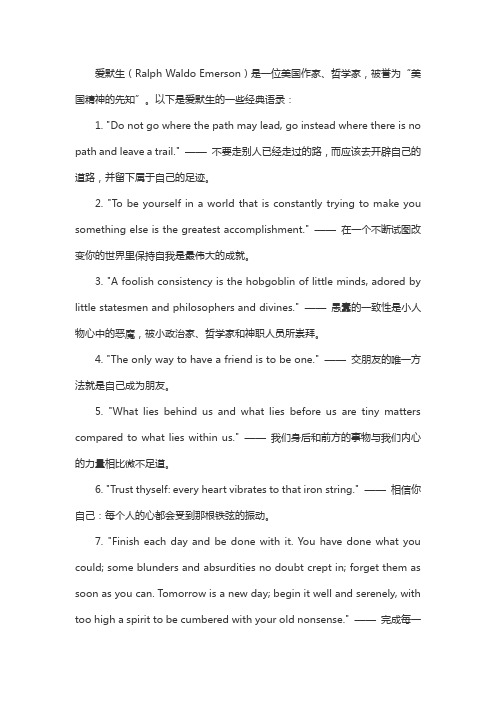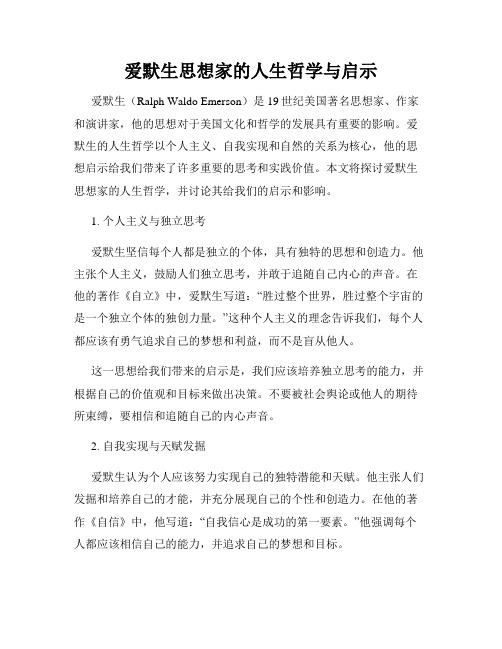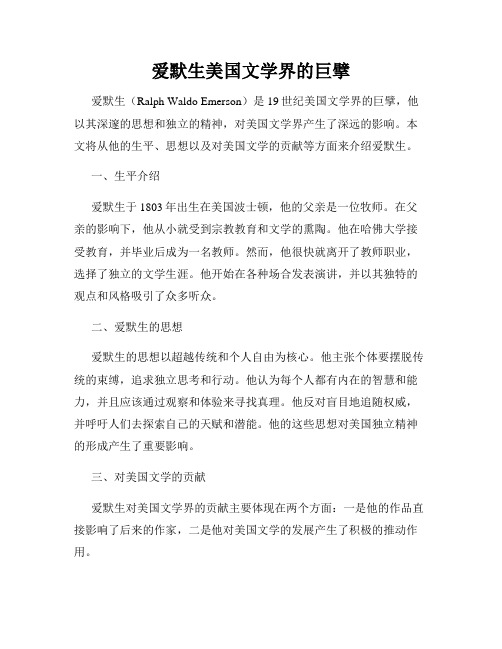爱默生
高考语文 人物篇:爱默生作文素材

语文:高考作文素材:人物篇——爱默生爱默生拉尔夫·瓦尔多·爱默生(RalphWaldoEmerson,1803~1882),美国散文作家、思想家、诗人和演说家。
他被认为是美国19世纪最伟大的人物之一,他的人本主义思想和自立主张对美国人民和美国历史的发展有着深远影响。
林肯曾高度赞扬他的思想,称他是“美国精神的先知”、“美国的孔子”。
文学批评家劳伦斯·布尔在《爱默生传》说,爱默生与他的学说,是美国最重要的世俗宗教。
爱默生1803年5月出生于马萨诸塞州波士顿附近的康考德村,1882年4月27日在波士顿因肺病逝世。
他出身牧师家庭,自幼丧父,由母亲和姑母抚养他成人。
曾就读于哈佛大学,在校期间,他阅读了大量英国浪漫主义作家的作品,丰富了思想,开阔了视野。
毕业后,曾执教两年,之后进入哈佛神学院,担任基督教惟一的神教派牧师,并开始布道。
1837年8月31日,爱默生在美国大学生联谊会上发表了《论美国学者》的著名演讲,这一演讲轰动一时,对美国民族文化的兴起产生了巨大影响,被誉为是美国“思想上的独立宣言”。
爱默生的著作大多是散文,主要作品包括《随笔》(1841)、《随笔:第二辑》(1844)、《代表人物》(1850)和《英国人的性格》(1856)等作品。
爱默生的散文写作非常有特色,文章注重思想内容而没有华丽的词藻,行文犹如格言,哲理深入浅出,说服力强,且有典型的“爱默生风格”。
有人这样评价他的文字——“爱默生似乎只写警句”。
这种风格和爱默生阅读广泛有关,也和他每年都写下的厚厚的笔记有关。
爱默生的传记作者小罗伯特·D·理查森说,爱默生不是一个系统的读者,但他是浏览和做综合笔记的天才,他是矿工们所说的高速鉴别机,通过对书籍资料广泛的挖掘,筛选最精华的部分。
Ww散文写作让爱默生进入了以蒙田为代表的经典随笔作家的行列,但按照爱默生最初的想法,也许他更钟爱的是自己诗人的这一角色。
爱默生自然哲学家

爱默生自然哲学家爱默生(Ralph Waldo Emerson)是19世纪美国的一位哲学家、文学家和演说家。
他以自然哲学的观点和思想在当时的美国产生了深远的影响。
本文将探讨爱默生作为一位自然哲学家的思想和对社会的影响。
爱默生的自然观爱默生的自然观可以追溯到康德、尼采等欧洲哲学家的思想,但他将这些思想与美国大陆的大自然结合起来,形成了独特的观点。
他认为自然是神圣的,人与自然应该和谐相处。
他主张通过近距离观察和体验大自然来获得真理和智慧。
他相信人们应该与自然保持联系,以获得心灵的平静和开放。
爱默生的自然观对于当时的美国社会产生了重要影响。
19世纪美国正经历工业革命和城市化的浪潮,许多人感到与自然的联系被断裂。
爱默生的观点鼓励人们重新回归自然,并对传统的文化和社会制度提出了挑战。
爱默生的个人发展在描述爱默生自然哲学家的思想前,了解其个人经历对我们理解他的观点和影响也十分重要。
爱默生出生于1803年,毕业于哈佛大学,之后担任过神职人员,在此期间他参与了各种学术和文化活动,结识了许多知识分子。
他于1832年辞去圣职,在接下来的几年中进行了一次欧洲之行,这对他的思想产生了重要影响。
在欧洲之行期间,爱默生与许多知名的哲学家和作家进行了交流和学术争鸣,这加深了他对于自然哲学的兴趣和研究。
他回到美国后开始了一系列的演讲和写作活动,这些活动使他逐渐成为了美国哲学和文学界的重要人物。
爱默生的自然哲学观点爱默生的自然哲学观点主要体现在他的作品《自然》中。
他认为自然是一部宏伟的大书,其中包含着无尽的智慧和真理。
他主张人们应该亲自体验自然,并从中汲取人生的启示。
他相信人与自然之间存在一种神秘的联系,只有通过亲身体验才能理解这种联系的奥秘。
爱默生的自然观点强调人与自然的和谐关系,反对人类对自然资源的滥用和破坏。
他认为人们应该以敬畏的心态对待自然,并保护大自然的美丽和完整性。
他的这种观点对于当时的美国来说,尤其是面临着环境破坏和资源浪费的问题的社会起到了积极的影响。
爱默生简介

爱默生简介姓名:爱默生性别:男出生年月:1803-1882年出生地:波士顿国籍:美国爱默生,r.w.(ralph waldo emerson 1803-1882)。
思想家、作家、诗人。
1803年5月25日生于波士顿一个牧师家庭。
1882年4月27日于马萨诸塞州康科德去世。
17岁毕业于哈佛学院。
1826年进入哈佛神学院学习,次年被获准讲道。
1828年成为波士顿第二教堂牧师,属于当时在新英格兰居优势的唯一神教派。
后因不赞成这一教派的某些教义,放弃神职,于1833年赴欧游历,拜访浪漫主义运动的先驱人物兰道尔、柯尔律治、华兹华斯等,与卡莱尔结为知交,并深受先验论的影响。
回国后于1836年出版《论自然》一书,这部书几乎包含了他所有重要的思想的胚芽。
1837年8月31日,爱默生在美国大学生联谊会上以《论美者》为题发表演讲,抨击美国社会中灵魂从属于金钱的拜金主义和资本主义劳动分工使人异化为物的现象,强调人的价值;提出学者的任务是自由而勇敢地从皮相中揭示真实,以鼓舞人、提高人、引导人;他号召发扬民族自尊心,反对一味追随外国的学说。
这一演讲轰动一时,对美国民族文化的兴起产生重大的影响,被霍尔姆斯誉为“我们的思想上的独立宣言”。
1838年7月15日,爱默生在剑桥的神学院发表题为《神学院致辞》的著名的演讲,遭到新英格兰加尔文教派、唯一种教派等势力的抗议和攻击。
爱默生的哲学思想中保持了唯一神教派强调人的价值的积极成分,又吸收了欧洲唯心主义先验论的思想,发展成为超验主义观点。
其基本出发点是反对权威,祟尚直觉;其核心是主张人能超越感觉和理性而直接认识真理。
这一观点有助于打破当时神学和外国的教条的束缚,建立民族文化,集中体现了时代精神,为美国政治上的民主主义和经济上资本主义的发展提供了理论根据。
自1836年开始,爱默生、阿尔科特、里普利等人在波士顿的康科德不定期地聚会讨论“神学与哲学的不良状况”,这可以说是超验主义运动的起点。
拉尔夫 沃尔多 爱默生

美国思想家文学家诗人
01 早年经历
03 人物评价
目录
02 文学生涯
基本信息
拉尔夫·沃尔多·爱默生(Ralph Waldo Emerson,1803年5月25日-1882年4月27日),生于美国波士顿。 美国思想家、文学家、诗人。爱默生是确立美国文化精神的代表人物,是新英格兰超验主义最杰出的代言人。美 国总统林肯称他为“美国的孔子”、“美国文明之父”。代表作品《论自然》,《美国学者》。其中《论自然》 被认为是新英格兰超验主义的圣经,而《美国学者》被誉为“美国思想文化领域的独立宣言”。他的哲学思想吸 收了欧洲唯心主义先验论,发展成为超验主义。
他的第一任妻子是埃伦·塔克,她在20岁时因罹患肺结核,于1831年2月8日过世。
1832年,一次与教会干事关于圣餐服务的管理权争执及关于公众祈祷的疑虑让他辞职了。1832年以后,爱 默生到欧洲各国游历,结识了浪漫主义先驱华兹华斯和柯尔律治,接受了他们的先验论思想,对他思想体系的形 成具有很大影响。
签名在1832年至33年间,爱默生到欧洲旅游,这段经历记载在《英国人的性格》(English Traits) (1856年)中。在旅途中,他遇到了威廉·华兹华斯、柯尔律治、约翰·斯图尔特·密尔和托马斯·卡莱尔。
文学生涯
论文集
人物影响
论文集
1840年爱默生任超验主义刊物《日晷》的主编,进一步宣扬超验主义思想。后来他把自己的演讲汇编成书, 这就是著名的《论文集》。《论文集》第一集于1841年发表,包括《论自助》("Self-Reliance")、《论超灵》 ("Over-soul")、《论补偿》、《论爱》、《论友谊》等12篇论文。三年后,《论文集》第二集也出版了。这 部著作为爱默生赢得了巨大的声誉,他的思想被称为超验主义的核心,他本人则被冠以“美国的文艺复兴领袖” 之美誉。
散文家:爱默生(美国)人物简介

爱默生对欧洲文学的影响
01
爱默生对英国文学的影响
• 对英国浪漫主义文学产生了重要影响
• 对英国文学的发展产生了深远影响
02
爱默生对法国文学的影响
• 对法国浪漫主义文学产生了重要影响
• 对法国文学的发展产生了深远影响
03
爱默生对德国文学的影响
• 对德国浪漫主义文学产生了重要影响
• 对德国文学的发展产生了深远影响
• 国际文学界的奖项
• 以爱默生的名字命名
• 表彰杰出的世界作家和哲学家
⌛️
谢谢观看.
Thank you for watching.
Docs
05
爱默生的生平与作品年表
爱默生的生平大事记
1821年进
入哈佛大
学
1829年成
为牧师
1840年代
辞去牧师
职务
1882年去
世
• 美国马萨诸塞州康
• 学习神学、古典文
• 在波士顿的圣保罗
• 专注于写作和演讲
• 美国马萨诸塞州康
科德市
学和哲学
教堂任职
• 成为美国文学和哲
科德市
• 出生于一个牧师家
• 对欧洲浪漫主义文
• 对美国文学和文化产生了深远影响
02
爱默生在世界文学史上的地位
• 被认为是浪漫主义文学的代表人物之一
• 对世界文学的发展产生了重要影响
03
爱默生的作品和思想对后世的影响
• 对美国文学和文化的发展产生了深远影响
• 对世界文学的发展产生了重要影响
03
爱默生的思想与哲学观念
爱默生的超验主义思想
超验主义的基本概念
• 对美国散文的发展产生重要影响
爱默生文学的智者

爱默生文学的智者爱默生(Ralph Waldo Emerson)是19世纪美国最著名的思想家和作家之一,他被誉为“爱国者之父”和“美国文学智者”。
他的作品集中展现了他对自然、社会和人类精神的独到见解。
本文将从他文学作品中挑选几个典型的例子,探讨爱默生是如何通过他的智慧和洞察力来影响人们的思考和行为。
首先,爱默生通过对自然的观察和思考,表达了他独特的见解和智慧。
在他的著名散文《自然》中,他强调人与自然的密切联系。
他认为,自然是我们最深层次的灵感和启示的源泉。
他通过描绘自然的壮丽景色和景观,表达了他对大自然的敬畏和敬仰之情。
他写道:“太阳升起,星星闪烁,山间流泉悠然流淌,这一切展现了上帝的伟大和智慧。
”爱默生的这种智慧和对自然的热爱,激励着读者去探索和欣赏自然之美。
其次,爱默生的作品中充满了对人类内心世界的深刻洞察。
在他的散文集《自我追求》中,他强调了个人的独立思考和自由意志的重要性。
他认为每个人都有能力发展自己的独特才能和潜力,并坚持自己的价值观和信仰。
他写道:“不要追随他人的意见,而要找到自己内心的声音,并紧随其后。
”爱默生对人类本质的理解和关怀,让读者深刻思考自己的生活和人生意义。
此外,爱默生的作品中还融入了对社会问题的深思熟虑和见解。
在他的论文《独立演讲》中,他呼吁人们摆脱传统和约束,勇敢地追求自己的梦想和独特之处。
他认为,个体的进步和自由是社会进步的基石。
他写道:“每个人都应该有机会追求自己的梦想,为自己的价值和事业奋斗。
”爱默生对社会自由和个人权利的抱负,为我们提供了重要的思考和行动的指导。
综上所述,爱默生文学作品中的智慧洞察力,极大地影响了人们的思考和行为。
他通过对自然的赞美、对人类内心世界的探索以及对社会问题的关怀,塑造了他作为一个智者的形象。
他的作品提醒我们,关注自然,追求个人的独立和自由,以及为社会的进步做出贡献的重要性。
作为读者,我们可以从爱默生的智慧中获得灵感,并运用到自己的生活中,不断成长和进步。
爱默生美国文豪励志提倡个人主义思想

爱默生美国文豪励志提倡个人主义思想在19世纪美国文学史上,有着许多杰出的作家。
其中,爱默生(Ralph Waldo Emerson)无疑是一位极其重要的文豪。
他以其深入而独特的思想观点和对个人主义的坚定提倡而闻名于世。
本文将对爱默生的美国文豪地位及其励志个人主义思想进行探讨。
第一部分:爱默生美国文豪地位的确立爱默生生于1803年,在他的一生中,他扮演着多重角色——一位作家、演说家、教育家以及社会活动家。
他的著作涵盖了广泛的主题,如自然、人性、独立思考等。
这些著作不仅影响了当时的美国社会,也对后世产生了深远的影响。
爱默生最著名的著作包括《自然》(Nature)、《人的理性及选举》(The American Scholar)和《个人主义》(Self-Reliance)等。
这些作品中的思想独到而深刻,使他成为19世纪美国文学的重要代表人物。
第二部分:爱默生的励志个人主义思想1. 自我实现与独立思考爱默生主张个体要追求真实的自我实现,并鼓励人们独立思考。
他认为每个人都有独特的才能和个性,应该追求自己内心的激情和天赋。
他在《自然》中写道:“谁想成为一个人类?谁就要拒绝一味跟随,而是要勇敢地表达自己的独立思想。
”2. 强调个体责任与勇气爱默生坚信,个人应该拥有自己的责任感,并为自己的信念而勇敢地奋斗。
他在《个人主义》中写道:“一个坚定的人从不依赖他人的力量,他所依赖的只是自己的思想和行动。
”他认为,只有勇往直前,个人才能实现真正的成功与成就。
第三部分:爱默生的影响和美国文化的发展1. 鼓舞人心的励志力量在爱默生的作品中,我们可以感受到一股强大的励志力量。
他的思想观点激励着人们追求自己的梦想、实现个人价值,并在困难面前坚持自己的信仰。
他的作品对美国文化在19世纪起到了积极的推动作用。
2. 个人主义的崛起与社会影响爱默生的个人主义思想对美国社会产生了深远的影响。
他强调每个人都应该独立思考、追求自我实现,这为美国的个人自由主义和民主理念提供了哲学基础。
Ralph Waldo Emerson

拉尔夫·沃尔多·爱默生
人物简介
主要作品 主要影响
名言警句
人物简介
拉尔夫•沃尔多•爱默生 (Ralph Waldo Emerson, 1803年—1882年),生于 波士顿。美国思想家、文 学家,诗人。爱默生是确 立美国文化精神的代表人 物,美国前总统林肯称他 为“美国的孔子”、“美 国文明之父”。
爱默生出身牧师家庭,自幼 丧父,由母亲和姑母抚养他成 人。曾就读于哈佛大学,在校 期间,他阅读了大量英国浪漫 主义作家的作品,丰富了思想, 开阔了视野。毕业后曾执教两 年,之后进入哈佛神学院,担 任基督教唯一的神教派牧师, 并开始布道。
主要作品
1835年,爱默生和其他志趣相投的知识分子创立 了“超验俱乐部”,直到1840年,爱默生用化名出版 了他的第一本小品文《论自然》(Nature)。
简陋的拱桥边下河水流淌, 旗帜迎着四月的微风飘扬, 从戎征战的农夫, 在此打响了声震全球的一枪。 敌人早已死去, 征服者正在安息; 时光把桥梁的残骸扫入了 那缓缓流向大海的暗淡江河小溪。 我们今天奉献上一座石碑, 在碧绿的岸上,在深沉平缓的河边; 愿人们的缅怀重现他们的伟绩, 直至我们的子孙,永远。 激励英雄拼死搏击、 换来儿辈自由的神灵啊, 嘱咐时光和自然慷慨保存下来 我们为英雄、为你竖起的这座丰碑。
Unless you try to do something beyond what you have already mastered, you will never grow. 如果你不尝试自己能力之外的事情,你永远不会成长。
1837年爱默生以《美国学者》为题发表了一篇著 名的演讲辞,宣告美国文学已脱离英国文学而独立, 告诫美国学者不要让学究习气蔓延,不要盲目地追随 传统,不要进行纯粹的摹仿。另外这篇讲辞还抨击了 美国社会的拜金主义,强调人的价值。被誉为美国思 想文化领域的“独ห้องสมุดไป่ตู้宣言”。
爱默生资料

爱默生(Ralph Waldo Emerson,1803-1882)是美国伟大的思想家、文学家、演说家、励志先驱,被称为―美国精神先知‖、―美国的孔子‖(林肯语),―确立美国文化精神的代表人物,就像雨果对于法国或是托尔斯泰对于俄国,爱默生确立了美国模式‖(约翰逊)。
旅居美国大半生的才女张爱玲一生只翻译了一册美国人的书,那就是―爱默生选集‖,她曾说过:―爱默生的作品即使在今日看来,也仍旧没有失去时效。
‖历史上,众多励志大师如戴尔·卡耐基、拿破仑·希尔、奥格·曼狄诺等曾经受到了爱默生―第一个论点依靠自我,尊重自我‖思想的影响和启发。
―依靠自我,尊重自我,独立自助,祟尚个性‖,这是美国精神的的突出特征,也是美国企业文化的精髓,美国社会的迅猛发展与美国个人才智的充分展现,正与这种精神息息相关。
Historically, many inspirational artists such as Dale Carnegie • Napoleon • Hill, Ogg • Man Dinuo so Emerson has been "to rely on self, respect f or self," thinking of the impact and inspiration. "Relying on self, respect for self and independent self-help, pursues individuality", which is the spirit of the prominent features of the United States, is the essence of American culture, American society and the rapid development of individual―美洲大陆的懒散智力,将要睁开它惺松的眼睑……我们依赖旁人的日子,我们师从它国的长期学徒时代即将结束。
爱默生自立解读

爱默生自立解读爱默生(Ralph Waldo Emerson)是19世纪美国著名的哲学家、作家和演讲家,他的思想对于美国文化和世界哲学产生了深远的影响。
其中,他提出的“自立”(self-reliance)的思想被视为他最重要的观点之一。
本文将对爱默生的自立思想进行解读,并进一步探讨其对现代社会的意义。
1. 自立的理念爱默生认为,每个人都应该注重个体的自由和独立。
他主张个人应该依靠自己的力量和智慧来实现最高的境界,而不是依赖外部因素或他人的指导。
自立不仅仅是一种独立思考的能力,更是一种追求自我价值、建立自信和掌握自身命运的态度。
2. 自立的实践在实践中,爱默生认为个体必须摆脱传统和社会对于个人的束缚,大胆地追求自己内心的喜好和追求。
他反对盲从,主张个体应该坚定自己的信念,并勇敢地表达出来。
他鼓励个人在探索和实践中寻找内心的真理,并将其付诸行动。
3. 自立与社会不仅仅是个体的价值追求,爱默生还强调自立对于整个社会的重要性。
他认为一个真正独立思考和自立的个体能够为社会带来积极和创造性的改变。
从这个角度来看,爱默生的自立思想也包含着对社会的责任感和奉献精神。
4. 现代社会的意义在当今社会,爱默生的自立思想仍然具有重要的意义。
随着科技的发展和信息的爆炸,我们时常被外界的声音和思想所影响,容易迷失自我。
而自立思想提醒着我们要清醒地认识自己,坚定地追求个人的理想和价值。
同时,自立还鼓励个人去发挥自己的才能和潜力,为社会带来积极的改变。
5. 自立的挑战然而,自立并不是一件容易的事情,它需要个体有坚定的意志和不断的努力。
在现实生活中,我们可能会遇到各种各样的压力和阻力,使得我们产生怀疑和动摇。
因此,要实现自立,我们需要不断地锻炼自己的思考能力、决策能力和行动力。
6. 自立的启示爱默生的自立思想给予我们很多启示。
首先,它提醒我们要放下过于依赖他人的心态,独立地思考和判断。
其次,自立思想教导我们要相信自己的内心,追求真理和内心的声音。
总结爱默生的主要思想

总结爱默生的主要思想爱默生(Ralph Waldo Emerson)是19世纪美国的一位著名思想家、作家和演说家,被誉为“美国文学之父”。
他的主要思想涵盖了哲学、文学和自由主义等多个领域,深受世界各地思想家和作家的影响。
以下是对爱默生主要思想的一个总结,旨在帮助读者更好地了解这位伟大文化的贡献。
1. 自我批判与独立思考:爱默生强调每个人都应该独立思考,不要轻易接受传统和权威的观点。
他主张人们要将个人的信念与内心的声音相结合,保持思想的独立性。
他认为个体应该对自己的行为负责,要勇敢地追求真理和意义,而不是盲目地遵从他人的规范和期望。
2. 自然主义与超越感:爱默生深信自然是人类进步与灵感的源泉。
他鼓励人们与自然相联系,并以其自然的力量寻找智慧和灵感。
他认为,通过观察自然,人们可以更好地理解自己和世界,实现自身的潜能。
3. 自我实现与自我完善:爱默生主张个体应该积极地发展自己的才能和潜能,以实现自己的目标和梦想。
他认为,人们应该坚持自己的独特性,不断探索和发展个人的精神和心灵。
个体的自我完善是一种持续的过程,它可以帮助人们不断超越自己,实现更高的目标。
4. 反传统与实用主义:爱默生对传统观念和制度持批判态度。
他主张人们应该独立思考,并根据自己的判断和经验去决定自己的行动。
他强调实用主义,即追求对个体和社会有积极影响的实际行动。
他反对空洞的理论和教条,强调实践的重要性。
5. 社会变革与个体责任:爱默生认为,社会变革应该由个体的行动和决定推动。
他主张每个人都应该承担起自己的责任,为社会变革和进步做出贡献。
他相信每个人的积极行动可以改变社会,实现更公正和自由的社会秩序。
6. 美学与自由创作:爱默生非常重视美学和文学的力量。
他鼓励人们追求艺术和文学创作,并将其用于表达思想和情感。
他认为艺术和文学的创作是人类精神和意志的表达,它可以提供灵感和启示,使人们更好地理解世界和自己。
总的来说,爱默生的思想可以概括为个体的独立性和责任心,与自然和社会的关系,以及个人追求真理和自我实现的重要性等方面。
爱默生的自然智慧

爱默生的自然智慧爱默生(Ralph Waldo Emerson)是19世纪美国的一位著名思想家、哲学家和作家,他被公认为是美国文学的重要人物之一。
他的许多作品都强调了与自然相连的重要性,提倡个人独立和自由的思考。
本文将探讨爱默生的自然智慧,解读他对自然界的独特见解以及这些见解对今天的启示。
一、爱默生与自然的关系爱默生深信人类与自然界之间存在一种紧密而和谐的联系。
他认为自然界是充满智慧的,人们可以通过观察和与之亲近来获取智慧。
他称这种智慧为“亲近自然的智慧(Wisdom of Nature)”。
爱默生相信,通过与自然界紧密接触,人们可以感受到自然的力量和美丽,从而更好地理解人类与自然之间的相互依存关系。
他主张个体应该与自然保持直接的联系,并通过亲身经历赋予自己智慧与洞察力。
二、爱默生的自然观在爱默生的作品中,他详细阐述了自己对自然的独特观点。
他认为自然是一种充满智慧和生命力的存在,每一个生命体都有其独特的目的和意义。
他称这种智慧为“自然智慧(Transcendental Wisdom)”。
爱默生相信自然是源源不断地变化和更新的,其中包含着无穷的智慧和启示。
他主张个体应该通过与自然的融合来获取这种智慧。
通过与自然的亲近,人们可以获得内在的平静和灵感,从而提升自己的生活质量和思维方式。
三、爱默生对教育的看法爱默生在自己的作品中强调了教育的重要性,并提出了一种新颖而与众不同的教育理念。
他主张教育应该注重培养个人独立思考和自由表达的能力。
他认为教育不应该仅仅是死记硬背和知识灌输,而应该通过激发学生的创造力和独立思考,培养他们成为自由而有思想的人。
爱默生强调了教育与自然的联系,他认为教育应该让学生更加亲近自然,通过与自然的互动来获取智慧和洞察。
他主张教育应该是一种与自然和谐相处的过程,而不仅仅是在教室里灌输知识。
四、爱默生的影响力爱默生对后世的影响深远。
他的作品激发了人们对自然的热爱和对个人独立思考的重视。
爱默生美国文学的前驱

爱默生美国文学的前驱爱默生(Ralph Waldo Emerson)是19世纪美国文学中的重要人物,他被誉为美国文学的前驱。
他的影响不仅仅局限于文学领域,还波及到哲学、社会学等多个学科。
本文将探讨爱默生在美国文学中的地位以及他的作品对后来的影响。
一、爱默生的生平及对美国文学的助推爱默生于1803年出生在美国麻塞诸塞州。
他的父亲是一个牧师,所以他从小就接触到了以宗教为主导的教育。
他在哈佛大学就读期间展现出了卓越的才华,受到了时任校长的赏识。
毕业后,他也选择成为一名牧师。
然而,爱默生的思想逐渐与传统的宗教观念背道而驰。
他开始质疑教会的权威和传统的道德规范。
这种思想转变使他逐渐摒弃了传统的宗教教义,转而追求个人的自由和灵性上的解放。
爱默生的不拘一格的思想和对个体的尊重,对美国文学产生了深远的影响。
他的作品是美国文学中的先驱,为后来的作家们铺平了道路。
他的散文作品《自立》(Self-Reliance)更是成为他最具代表性的作品之一。
二、爱默生的作品风格及主题爱默生的作品风格简洁明快,富有哲学思辨。
他的散文作品充满了智慧和对生命的探索。
他试图揭示人们内心深处的真实自我,并鼓励人们追求个人的自由和独立。
他的作品贴近现实生活,引导人们独立思考和探索。
他提出了“超验主义”(Transcendentalism)的概念,认为人类能够通过思考和直觉超越理性,与宇宙建立内在的联系。
爱默生的作品涉及多个主题,包括自由、独立、自我价值以及与自然的关系。
他主张个人在面对外部压力时应保持独立和坚韧,追求内心真实的声音。
他强调每个人都有独特的价值,应该为自己的追求而努力。
三、爱默生对后来作家的影响爱默生的作品对后来的作家产生了深远的影响。
他的思想和风格激发了许多作家的创作灵感,塑造了美国文学的发展方向。
其中,最为受影响的作家之一是亨利·戴维·梭罗(Henry David Thoreau)。
梭罗在爱默生的指导下成为了一个优秀的作家和哲学家。
爱默生故事美国文学的先知

爱默生故事美国文学的先知在美国文学的历史中,爱默生(Ralph Waldo Emerson)被誉为先知般的存在。
他以其独特的文学风格和思想观点,深深影响了后来的文学作品和作家们。
本文将探讨爱默生的故事,以及他在美国文学中的地位和影响。
1. 爱默生的故事爱默生是19世纪美国最重要的思想家之一,也是一位作家和演讲家。
他的思想受到了启蒙运动的影响,主张个人自由和独立思考。
他的作品以散文为主,以其简洁明了的语言和超凡脱俗的思想观点而著称。
2. 爱默生的思想观点2.1 自我实现爱默生主张个人自由和自我实现。
他认为每个人都拥有独特的天赋和潜力,应该追求个人的目标和价值。
他鼓励人们摆脱传统的束缚,大胆追求自己的梦想,并以自己的方式去发现真理和美。
2.2 与自然合而为一在爱默生看来,自然是一个强大而神秘的存在,人们应该与自然保持联系和和谐。
他赞美自然的壮美和神奇,并认为在自然中可以找到真理和智慧。
他主张人与自然的合而为一,以此来提升自己的灵性和智力水平。
2.3 自信和独立思考爱默生鼓励人们保持自信,并独立思考。
他认为每个人都应该根据自己的判断力和直觉去思考问题,而不是盲从他人的意见。
他主张人们要敢于表达自己的观点,坚持自己的信念,不受他人的干扰和压力。
3. 爱默生在美国文学中的地位和影响爱默生被视为美国文学的先知,他的作品对后来的文学界产生了深远的影响。
他的散文作品和思想观点启发了许多重要的作家,如亨利·戴维·梭罗(Henry David Thoreau)和沃尔特·惠特曼(Walt Whitman)等。
3.1 亨利·戴维·梭罗梭罗是一位重要的美国作家和哲学家,他的作品反映了他对自然和个人自由的追求。
他曾是爱默生的学生和好友,爱默生的思想对他的创作产生了重大影响。
梭罗的作品《瓦尔登湖》(Walden)中表达了和爱默生类似的思想,强调个人独立和自我实现。
3.2 沃尔特·惠特曼惠特曼是一位著名的诗人,他以其大胆的风格和自由的思想而闻名。
总结爱默生的主要思想

总结爱默生的主要思想拉尔夫·沃尔多·爱默生(Ralph Waldo Emerson)是19世纪美国最重要的思想家之一,也是美国文化的奠基人之一。
他的思想涵盖了广泛的领域,如个人主义、自由主义、民主主义、自然主义和转化主义。
他的作品中,尤其以《自我信仰》、《自然》和《社会学》为代表,集中体现了他的核心思想。
爱默生的核心思想之一是关于“自我的重要性”。
他认为,每个人都有独特的价值和潜力,应该追求个人发展和自我实现。
他强调个人独立和自由的重要性,反对一切压制个人自由的形式。
他提倡人们去追寻内心的声音,并勇敢地践行自己的信仰。
他认为,只有当个人忠于自我时,才能真正找到幸福和真理。
爱默生的另一个核心思想是关于“自然的力量”。
他认为,自然是一个伟大而神圣的力量,人们应该与之和谐相处。
他赞美自然的美丽和神奇,主张人们去感受大自然的力量,从中获取智慧和启示。
他认为,自然是个人和宇宙之间的纽带,人们应该意识到自己与自然的相互关系,以此来实现个人的成长和完善。
爱默生的最后一个核心思想是关于“转化的力量”。
他认为,个人应该不断地转变和成长,以适应不断变化的世界。
他强调个人的内在力量和潜能,主张人们通过思考和改变自己的态度和行为,去实现个人的转化和改进。
他认为,人们应该追求真理和智慧,并对自己的思想和行为进行持续的反思和修正。
爱默生的思想对美国文化和世界思想产生了巨大的影响。
他的个人主义和自由主义观点,对美国的独立精神和民主传统起到了推动作用。
他的思想也在全球范围内产生了影响,尤其是在亚洲国家,如日本和印度。
他的强调个人独立和自由的思想,为这些国家追求独立和自由做出了重要的贡献。
总而言之,爱默生的思想集中体现了个人主义、自由主义和民主主义的核心理念。
他强调个人的独立和自由,并主张个人去追求真理和智慧,实现个人的成长和转化。
他的思想对美国文化和世界思想产生了深远的影响。
爱默生的思想如今仍然被广泛研究和借鉴,为当代社会提供了重要的思想资源。
爱默生经典语录

爱默生(Ralph Waldo Emerson)是一位美国作家、哲学家,被誉为“美国精神的先知”。
以下是爱默生的一些经典语录:1. "Do not go where the path may lead, go instead where there is no path and leave a trail." ——不要走别人已经走过的路,而应该去开辟自己的道路,并留下属于自己的足迹。
2. "To be yourself in a world that is constantly trying to make you something else is the greatest accomplishment." ——在一个不断试图改变你的世界里保持自我是最伟大的成就。
3. "A foolish consistency is the hobgoblin of little minds, adored by little statesmen and philosophers and divines." ——愚蠢的一致性是小人物心中的恶魔,被小政治家、哲学家和神职人员所崇拜。
4. "The only way to have a friend is to be one." ——交朋友的唯一方法就是自己成为朋友。
5. "What lies behind us and what lies before us are tiny matters compared to what lies within us." ——我们身后和前方的事物与我们内心的力量相比微不足道。
6. "Trust thyself: every heart vibrates to that iron string." ——相信你自己:每个人的心都会受到那根铁弦的振动。
爱默生美国文学鼻祖的超验主义思想

爱默生美国文学鼻祖的超验主义思想在19世纪的美国文学史上,拉尔夫·瓦尔多·爱默生(Ralph Waldo Emerson)是一位不可忽视的重要人物。
他被誉为美国文学的鼻祖,是超验主义思想的先驱。
本文将探讨爱默生的超验主义思想以及其在美国文学中的影响。
一、超验主义的核心思想超验主义是19世纪美国文学与哲学的重要思潮之一,强调个体意识的自由思考和直觉,并体现了对自然界的崇拜和对人类心灵与自然的融合。
爱默生认为,每个人都可以通过直接的直觉和某些心灵的洞察力来认识真理,而不必完全依赖于逻辑推理。
其次,超验主义还注重个体与社会的关系。
爱默生主张人们应该有勇气表达自我,摆脱传统的束缚,寻找自己独特的价值和使命。
他认为每个人都是独一无二的,都具有独特的天赋和才华,应该追求个体的独立和自由。
二、超验主义在爱默生的作品中的体现1.《自然》《自然》是爱默生最具代表性的著作之一,也是他超验主义思想的宣言。
在这本书中,爱默生探讨了自然界与人类之间的关系,并认为直接感知自然可以带来心灵上的平静和启迪。
他强调自然是一本巨大的书籍,宇宙是一个大教堂,人们应该去观察、思考和感知自然的奥秘。
2.《论自我》《论自我》是爱默生的另一部重要著作,他在其中解释了个人与自我之间的关系。
他认为自我是一个独特的存在,是与众不同的。
爱默生主张个体应该追寻内心的真实自我,摆脱社会的期望和价值观的束缚,勇敢地践行自我。
3.诗歌作品爱默生不仅是一位哲学家和思想家,还是一位才华横溢的诗人。
他的诗歌作品通常以叙述真实的自然景观和探索个体内心起伏的情感为主题。
他的诗歌作品深受超验主义思想的影响,强调直觉和感知的力量,表达了对自然界美的赞美和对人类精神的探索。
三、超验主义对美国文学的影响爱默生的超验主义思想对美国文学产生了深远的影响。
它鼓励作家勇敢地探索内心世界和直觉的力量,寻找个人的独特价值和使命。
超验主义思想促使作家们拒绝传统的形式和约束,追求写作的自由和创新,对美国文学带来了新的思维模式和艺术风格。
爱默生思想家的人生哲学与启示

爱默生思想家的人生哲学与启示爱默生(Ralph Waldo Emerson)是19世纪美国著名思想家、作家和演讲家,他的思想对于美国文化和哲学的发展具有重要的影响。
爱默生的人生哲学以个人主义、自我实现和自然的关系为核心,他的思想启示给我们带来了许多重要的思考和实践价值。
本文将探讨爱默生思想家的人生哲学,并讨论其给我们的启示和影响。
1. 个人主义与独立思考爱默生坚信每个人都是独立的个体,具有独特的思想和创造力。
他主张个人主义,鼓励人们独立思考,并敢于追随自己内心的声音。
在他的著作《自立》中,爱默生写道:“胜过整个世界,胜过整个宇宙的是一个独立个体的独创力量。
”这种个人主义的理念告诉我们,每个人都应该有勇气追求自己的梦想和利益,而不是盲从他人。
这一思想给我们带来的启示是,我们应该培养独立思考的能力,并根据自己的价值观和目标来做出决策。
不要被社会舆论或他人的期待所束缚,要相信和追随自己的内心声音。
2. 自我实现与天赋发掘爱默生认为个人应该努力实现自己的独特潜能和天赋。
他主张人们发掘和培养自己的才能,并充分展现自己的个性和创造力。
在他的著作《自信》中,他写道:“自我信心是成功的第一要素。
”他强调每个人都应该相信自己的能力,并追求自己的梦想和目标。
这一思想给我们带来的启示是,我们应该积极发掘自己的天赋和潜能,并在实现个人目标的道路上坚定信心。
只有相信自己,才能找到真正属于自己的意义和成就。
3. 自然与灵性爱默生深信自然是人们取得灵感和平静的源泉。
他强调人与自然的关系,鼓励人们去感知和欣赏大自然的美丽和智慧。
在他的著作《自然》中,他写道:“在自然中,我找到了答案。
”他认为自然可以唤醒我们的灵感和创造力,让我们更加接近自己的内心世界。
这一思想给我们带来的启示是,我们应该与自然建立更密切的联系,并从中汲取力量和智慧。
无论是在大自然中散步、观察星空,还是在花园里种植、享受阳光,都可以让我们与自身的内在世界更加和谐,找到平衡和灵感。
爱默生美国文学界的巨擘

爱默生美国文学界的巨擘爱默生(Ralph Waldo Emerson)是19世纪美国文学界的巨擘,他以其深邃的思想和独立的精神,对美国文学界产生了深远的影响。
本文将从他的生平、思想以及对美国文学的贡献等方面来介绍爱默生。
一、生平介绍爱默生于1803年出生在美国波士顿,他的父亲是一位牧师。
在父亲的影响下,他从小就受到宗教教育和文学的熏陶。
他在哈佛大学接受教育,并毕业后成为一名教师。
然而,他很快就离开了教师职业,选择了独立的文学生涯。
他开始在各种场合发表演讲,并以其独特的观点和风格吸引了众多听众。
二、爱默生的思想爱默生的思想以超越传统和个人自由为核心。
他主张个体要摆脱传统的束缚,追求独立思考和行动。
他认为每个人都有内在的智慧和能力,并且应该通过观察和体验来寻找真理。
他反对盲目地追随权威,并呼吁人们去探索自己的天赋和潜能。
他的这些思想对美国独立精神的形成产生了重要影响。
三、对美国文学的贡献爱默生对美国文学界的贡献主要体现在两个方面:一是他的作品直接影响了后来的作家,二是他对美国文学的发展产生了积极的推动作用。
爱默生的作品充满了独特的思想和观点,比如他的代表作《自然》中强调了与自然的和谐相处以及反对社会陈规的主张。
这些作品激发了后来许多作家的灵感,他们通过接纳和发展爱默生的思想,进一步丰富了美国文学的内涵。
此外,爱默生在美国文学界的发展中,也起到了积极的推动作用。
他是泰州文学会(Transcendental Club)的创始人之一,该组织为许多新兴作家提供了交流和合作的平台。
通过这个组织,爱默生与其他重要的文学家,如亨利·戴维·梭罗(Henry David Thoreau)和威廉·詹姆斯(William James)等建立了深厚的友谊和合作关系。
这种合作和交流的氛围促进了美国文学的繁荣。
四、爱默生的影响爱默生的观点和作品不仅影响了美国文学界,也对其他领域产生了影响。
他的思想对美国哲学、宗教和政治等领域产生了深远的影响。
爱默生的自我概念

爱默生的自我概念爱默生(Ralph Waldo Emerson)是19世纪美国的一位重要思想家、作家和演讲家,以其独特而深刻的自我概念而著名。
他的自我概念涉及个体自由、独立思考和追求真实的能力,以及与自然和宇宙的联系。
以下是对爱默生自我概念的详细阐述。
首先,爱默生的自我概念与个体的自由和独立思考密切相关。
他反对一切形式的奴役和从众,主张每个人都有权利独立思考、独立行动,并且根据自己的信念和价值观做出决策。
他认为,个体应该摆脱传统、习俗和社会压力,将自己的命运掌握在自己手中。
通过独立思考和自由选择,个体能够找到真正属于自己的道路和意义,实现自我实现和自我完善。
其次,爱默生将自我概念与个体内在的力量和潜能联系在一起。
他认为,每个人都有自己独特的才华、能力和激情,只有发掘和发挥这些潜能,才能实现真正的自我。
他鼓励个体积极探索自己的内心世界,寻找内在的真理和智慧。
他认为,只有通过自我发现和自我实现,个体才能找到真正的幸福和成就。
此外,爱默生将自我概念与个体与自然和宇宙的联系紧密结合在一起。
他认为,个体不应该将自己看作与自然和宇宙分离的存在,而是与之紧密相连的一部分。
他主张个体应该与自然界保持和谐,感受大自然的力量和美丽,从中获得启示和智慧。
他认为,个体通过与自然互动和联系,能够发现自身的内在秘密和宇宙的真理,从而实现真正的自我。
此外,爱默生的自我概念还强调了个体的责任和对他人的关爱。
他认为,个体的自我实现和幸福并不是与他人利益的冲突,而是与之相辅相成的。
他鼓励个体在追求自我梦想和理想的同时,关心他人和社会,为他人的幸福和福祉作出贡献。
他认为,个体通过为他人提供价值和帮助,能够找到更高的使命和内在的满足感。
总之,爱默生的自我概念强调了个体的自由、独立思考和追求真实的能力,以及与自然和宇宙的联系。
他主张个体摆脱外界的影响和束缚,发掘和发挥自己的潜能,实现真正的自我。
他认为,个体通过与自然和宇宙的互动和联系,能够获得启示和智慧,找到真正属于自己的道路和意义。
- 1、下载文档前请自行甄别文档内容的完整性,平台不提供额外的编辑、内容补充、找答案等附加服务。
- 2、"仅部分预览"的文档,不可在线预览部分如存在完整性等问题,可反馈申请退款(可完整预览的文档不适用该条件!)。
- 3、如文档侵犯您的权益,请联系客服反馈,我们会尽快为您处理(人工客服工作时间:9:00-18:30)。
波士顿的第二堂邀请艾默生作为其初级牧师,他被规定于1829年1月11日。 [31]他最初的工资是每年1200美元,增加1400美元7月, [32]但他的教会的角色,他承担了其他职责:他是神父对马萨诸塞州的立法机关,以及波士顿学校委员会的成员。 他教会活动让他忙,尽管在此期间,面对他的妻子死到临头了,他开始怀疑自己的信仰。
艾默生遇见了他的第一任妻子,艾伦路易莎塔克,在新罕布什尔州康科德的圣诞节,1827年,并娶了她,当她是18。 [26]这对夫妻搬到了波士顿,与艾默生的母亲露丝移动与他们帮忙照顾。艾伦,谁是已经患有结核病[27] 。“我没有忘记的平安和喜乐”:不到两年后,艾伦在20岁时于1831年2月8日,说出她的最后一句话后死亡[28 ]艾默生,严重地影响了她的死亡,并参观了她在Roxbury的坟墓(每日)。 [29]在日期为1832年3月29日日记条目,爱默生写道,“我访问了艾伦的陵墓和打开棺材。” [30]
艾默生回到了美国对1833年10月9日,和住在一起,他的母亲在马萨诸塞州牛顿市,到十月,1834年,当他搬到康科德,马萨诸塞州 ,与他的继祖父博士住以斯拉里普利什么,后来命名旧万岁 。 [44]眼看着含苞待放学园运动,提供讲座各类话题,艾默生看到一个可能的职业生涯作为一个讲师。 11月5日1833年,他做了一个什么最终将是大约1500名讲座,讨论在波士顿自然历史博物馆的用途。 这是他在巴黎的经验,扩大帐户。 [45]在这个演讲中,他列出了他的一些重要的信念和想法,他会在他的第一次出版的散文性质后开发:
Emerson wrote on a number of subjects, never espousing fixed philosophical tenets, but developing certain ideas such as individuality, freedom, the ability for humankind to realize almost anything, and the relationship between the soul and the surrounding world. Emerson's "nature" was more philosophical than naturalistic: "Philosophically considered, the universe is composed of Nature and the Soul."
?"The Poet" (Essays: Second Series)
?"Experience" (Essays: Second Series)
?"Politics" (Second Series)
?"The American Scholar"
?"New England Reformers"
His essays remain among the linchpins of American thinking,[citation needed] and his work has greatly influenced the thinkers, writers and poets that have followed him. When asked to sum up his work, he said his central doctrine was "the infinitude of the private man."[2] Emerson is also well known as a mentor and friend of fellow Transcendentalist Henry David Thoreau.[3]
艾默生欧洲巡回演出于1833年,后来在英文性状 (1856)写了他的旅行。 [37]他离开这艘双桅船碧玉在圣诞节,1832年,第一次航行到马耳他。 [38]在他的欧洲之旅,他花了几个月在意大利,游览罗马,佛罗伦萨和威尼斯等城市之间。 在罗马,他会见了约翰·斯图亚特·穆勒 ,谁给了他一封推荐信,以满足托马斯卡莱尔 。 他去了瑞士,并且必须由同车的乘客被拖进参观伏尔泰的家在费内,“在他的记忆的无价值抗议所有道路。” [39]接着,他到了巴黎,一个“响亮的现代新一个地方的纽约,“ [40]他在那里参观了植物园 。 他极大地被植物的根据组织移动加希耶分类的系统的方式,以及所有这些物体相关的连接。 正如理查森说,“艾默生的时刻洞察的东西,在植物园的相互联系几乎是有远见强度的时刻,指出他从神学和对科学的。” [41]
Individual essays
?"Nature" (1836)
?"Self-Reliance" (Essays: First Series)
?"Compensation" (First Series)
?"The Over-Soul" (First Series)
?"Circles" (First Series)
“ 乌列 “
“ 冰雪风暴(诗) “
[ 165 ]
经过哈佛,艾默生协助他的兄弟威廉[20]在一所学校为年轻女性[21]建立了自己的母亲的房子,他已经建立了自己的学校后, 马萨诸塞州切姆斯福德 ,当他的弟弟威廉[22]去哥廷根留学神威,艾默生主持学校。 在接下来的几年里,艾默生使他的生活作为一个校长,然后去哈佛神学院 。 爱默生的弟弟爱德华, [23]小两岁,比他,进入了律师的办公室丹尼尔·韦伯斯特 ,在他的第一类哈佛大学毕业后。 爱德华的身体健康开始恶化,他很快就遭遇了精神崩溃,以及,他是在23岁到采取庇护麦克莱恩在1828年6月。 虽然他恢复了他的心理平衡,他于1834年从表面长期死于肺结核 。 [24]另一种艾默生光明和充满希望的弟弟,查尔斯,出生于1808年,于1836年去世,也结核病, [25]这使得他成为第三年轻人在艾默生的最里圈在一段几年就不行了。
Ralph Waldo Emerson (May 25, 1803 – April 27, 1882) was an American essayist, lecturer, and poet, who led the Transcendentalist movement of the mid-19th century. He was seen as a champion of individualism and a prescient critic of the countervailing pressures of society, and he disseminated his thoughts through dozens of published essays and more than 1,500 public lectures across the United States.
?English Traits (1856)
?The Conduct of Life (1860)
?May Day and Other Poems (1867)
?Society and Solitude (1870)
?Letters and Social Aims (1876)
他的妻子去世后,他开始不同意教会的方法,写在他的日记在1832年6月:“我有时觉得,为了成为一个好牧师,有必要让该部的专业是过时的。在一个改变的时代,我们崇拜我们祖先的死亡形式。“ [33]他的分歧与教会官员对的管理共融的服务和对公共祈祷疑虑最终导致了他的辞职于1832年。 正如他写道,“纪念基督的这种模式是不适合我,这是足够的理由为什么我应该放弃它。” [34] [35]正如一位艾默生学者所指出的那样,“落纱牧师的体面的黑色,他是自由选择一个机构或一个传统的范围内并不局限于思想家的讲师和教师,的礼服。“ [36]
收藏
散文:第一辑(1841)
散文:第二辑(1844)
诗(1847)
自然,地址和讲座(1849)
代表男性(1850)
英语性状(1856)
处世之道(1860)
五一节和其他诗(1867)
社会与孤独(1870)
字母和社会目标(1876年)
个人随笔
“ 自然 “(1836)
Collections
?Essays: First Series (1841)
?Essays: Second Series (1844)
?Poems (1847)
?Nature; Addresses and Lectures (1849)
?Representative Men (1850)
“ 自力更生 “(散文:第一辑)
“ 补偿 “(第一辑)
“ 超额魂 “(第一辑)
“ 圆 “(第一辑)
“ 诗人 “(散文:第二辑)
“ 体验 “(散文:第二辑)
“ 政治学 “(第二辑)
“ 美国的学者 “
“ 新英格兰改革者 “
诗
“ 协和赞美诗 “
“ 该Rhodora “
“ 梵天 “
北移到英国,艾默生遇见威廉·华兹华斯 , 塞缪尔·泰勒·柯勒律治和卡莱尔 。 凯雷尤其是对艾默生强大的影响力;艾默生以后将作为凯雷一个非官方的文学代理人在美国,和1835年3月,他试图说服凯雷来美国讲学。 [42]这两个将维持对应到凯雷去世于1881年。 [43]
ห้องสมุดไป่ตู้
达盖尔银版的莉迪亚·杰克逊爱默生和儿子爱德华·沃尔多·爱默生未知的日期
Emerson wrote most of his important essays as lectures first, then revised them for print. His first two collections of essays – Essays: First Series and Essays: Second Series, published respectively in 1841 and 1844 – represent the core of his thinking, and include such well-known essays as Self-Reliance, The Over-Soul, Circles, The Poet and Experience. Together with Nature, these essays made the decade from the mid-1830s to the mid-1840s Emerson's most fertile period.
